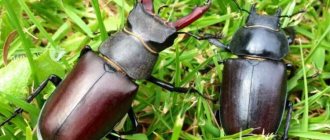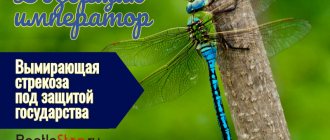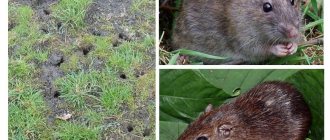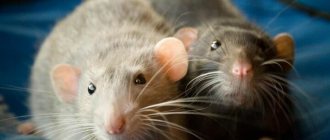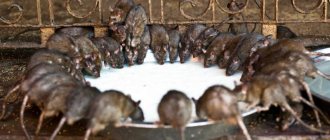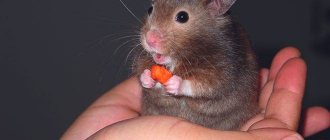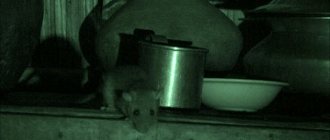- Wild animals
- >>
- Mammals
The water rat or water vole is a frequently encountered animal in our area. A small rodent that lives near water bodies. These are very cute and harmless animals in appearance, however, in agriculture, water rats are considered dangerous pests due to the fact that they cause damage to trees and crops. They are carriers of many dangerous diseases.
Description of the rodent
Muskrat in its natural habitat
– Advertisement –
In appearance, the muskrat is similar to a rat, which is why it also received the name “musk rat.” But this species is larger than the common gray rat.
- Latin name: Ondatra zibethicus
- Kingdom: Animals
- Class: Mammals
- Order: Rodents
- Family: Hamsters
Dimensions
- The weight of adult individuals reaches 1.8 kg, with an average of 1-1.5 kg.
- Body length from 23 to 36 cm,
- The length of the tail is almost equal to the length of the body and is 18-28 cm.
Related species
Water rat
The muskrat's closest relative is the water rat. The animal has a more rounded body and a shortened muzzle. The weight of a water rat depends on the time of year and feeding conditions, but on average it is about 200 - 300 grams with a body length of up to 25 cm. The water rat moves more by jumping, is not a bad swimmer, but prefers to spend most of its time on land. Prefers to settle near water bodies and in wetlands. With the arrival of cold weather, animals move closer to human homes - they can live in basements and sheds, garages and even in residential buildings.
Nutria
Muskrat and nutria belong to the same family and to a layman they look very similar. However, the difference between the species is large: nutria is much larger, it has a large head with rather small eyes and ears. The short muzzle ends in long and stiff mustaches. The weight of nutria can reach up to ten kilograms with a body length of up to a meter. In appearance, the nutria swimming along the river looks more like a beaver. The animal's fur is dense, thick, and can be either reddish-gray or almost brown. The long tail is practically hairless and serves as a rudder. Nutria feeds on plant foods, preferring roots and young shoots of sedge and reeds. They do not eat insects and frogs, as well as small fish, as actively as muskrats.
Very often the muskrat is confused with the otter, although these animals are not only not close relatives, but also have completely different appearances.
The otter belongs to the mustelidae family. But this is not the only difference between the two animals. The animal settles near bodies of water and leads a semi-aquatic lifestyle, feeding mainly on fish, shellfish, frogs, bird eggs and birds. Often the otter also hunts the muskrat. Otters always dig their burrows on the shore. The body of the animal is long and has a well-streamlined shape. The length of an adult, including its tail, can reach one and a half meters. Weight - about 6 - 10 kg. The color is predominantly dark brown. The animal's muzzle is elongated, with large and expressive eyes. The animal has sharp teeth. The otter's legs are short but strong. There are membranes between the toes that allow the otter to swim perfectly.
What does a muskrat look like?
Torso
The body is thick, the neck is short, the head is small, and the muzzle is blunt. The animal is anatomically perfectly adapted to a semi-aquatic lifestyle. The ears protrude slightly from the fur, the eyes are small and set high.
Teeth
Muskrat close-
up Teeth grow over the incisors and separate them from the oral cavity, thanks to this the animal bites off plants under water and does not choke.
Tail
— Advertising —
Muskrat after another swim
The tail is flat on the sides, its surface is covered with small scales and hairs, and on the underside there is a comb of long, hard hair. Swimming membranes are located on the hind legs, and short hairs grow along the edges of the toes.
Fur and color
Muskrat with light fur color
The muskrat's fur contains coarse guard hairs and soft undercoat. The back and paws are colored from dark brown to black. The belly is light, occasionally grayish-blue. In summer the fur becomes lighter. Overall it is thick, dense, lush and waterproof. The muskrat carefully lubricates it with fatty secretions and combs it.
The hemoglobin content in the rodent's blood is increased, and there is a lot of myoglobin in the muscles; this is an additional supply of oxygen for diving under water. The muskrat is also characterized by the phenomenon of heterothermy, that is, the ability to regulate blood flow to the paws and tail. The paws are usually cooler than the rest of the body.
Rat poison against water vole
You can poison a rodent with poison.
Buying poison is not difficult. You can attract the animal with bait. To do this, use the crust of bread, cookies, and grain. They are ground with rat poison, and bait is placed at the base of the holes. Having tasted such a delicacy, the vole will surely die. And in order for the water rat to do this more willingly, it should initially be fed with the same bait, but without poison. When the animal calms down, it will eat the treat without fear. Then feed the water rat poison. However, this not very humane method of struggle has several disadvantages. Other animals, and even pets who like to walk around the garden, in the garden, or in flower beds, can become poisoned. In addition, after death, the water rat will begin to decompose. Finding all the corpses may be difficult. And it’s not just the unpleasant aroma, but the bacteria and microorganisms that are present on the decomposing body. For example, potatoes, beets, and carrots can be hazardous to health.
What does it eat?
A muskrat eats - photo The
muskrat's diet includes aquatic plants, for example, reeds, cattails, reeds, sedges, horsetails, arrowheads, and pondweeds. In the spring, the muskrat feeds on young stems and leaves, in the summer and autumn it eats the root parts of plants and rhizomes, and in the winter it eats only rhizomes. In addition, the animal can also feed on agricultural crops. If plant food becomes scarce, it switches to animal food, shellfish, frogs and fish fry.
Getting Rid of a Water Rat
Human efforts are directed more toward expulsion than destruction. Use inhumanely and dangerously. Domestic cats, dogs, and other animals that are natural enemies of rats can suffer from poisoned bait. The exceptions are large fields, premises - barns, storage facilities. There you can fight with rat poison.
Traps are not suitable for use in open areas. The product performs well in barns, storage facilities, and cellars. They even use glue traps where possible.
The main task is to expel them from the garden, field, garden or prevent entry.
- Fence your plot of land or garden with a fence with small gaps, concrete the bottom or lay a row of bricks. The water rat will not undermine the ground.
- In the garden, plant legumes, onions, garlic, and peppermint in different areas. Rodents cannot tolerate these odors.
- Wormwood, tansy, chamomile, and peppermint are scattered across the beds.
- When holes are found, rags soaked in kerosene, gasoline, naphthalene, and acetone are stuffed into the hole. To make the smell last a long time, place the rag in a plastic bag and make a small hole in it.
- The wool is set on fire and placed near the hole. This smell drives out pests almost immediately.
- Scatter balls of burdock around the garden. Water rats are afraid of the weed because of its thorns. It sticks tightly to the fur, restricts movement, and causes a lot of inconvenience.
- Sprinkle wood ash. It irritates the skin and causes upset if it enters the stomach. Constant poor health forces the rodent to leave the intended territory.
- Trees are coated with lime in combination with copper sulfate. In the fall, a belt is constructed from different materials: pine branches, plastic bottles, roofing felt, etc.
The fight against rodents is carried out using folk methods. The main task is to expel them from the territory and prevent re-entry. There is no point in destroying fur-bearing animals recklessly.
Where does it live?
Highlighted areas on the world map where the muskrat lives
The muskrat was originally found in North America from Alaska and Labrador to Texas and northern Mexico. It was introduced into Europe several times, as a result of which the species spread widely in Eurasia to Mongolia, China and Korea.
In Russia, the muskrat's habitat starts from Finland and extends through the forest zone of the European part to Siberia, the Far East and Kamchatka.
In addition, the muskrat lives in Israel, along the banks of fresh rivers.
Folk remedies
Traditional methods are also used to combat water rats. But these methods are more aimed at scaring away rodents, rather than physically exterminating them. Help get rid of these pests:
To prevent water rats, keep the area clean
- singed wool;
- black elderberry;
- spruce spruce branches and juniper branches;
- wood ash.
Rats cannot stand the smell of some plants, but black elderberry is especially effective on them. Its roots release cyanide into the soil, so all rodents tend to leave this place quickly. Spruce and juniper branches act differently, not due to their smell. Rats have bare feet and try not to step on needles or anything sharp. Therefore, it is good to cover fruit trees on the site with coniferous branches for the winter to protect their bark from damage by rodents.
Ash, which is a caustic alkali, also works well on them. It sticks to the rats' paws, and when they lick them, the ash enters the body, which does not have the best effect on the rodent's digestion.
Rats also cannot stand the smell of burning wool, and some gardeners use this old method of dealing with them. They set the rat carcass on fire and stuff it into the rodent's hole. As a result of such actions, other relatives of this rat begin to leave their favorite area. Instead of a rat carcass, you can use any trimmings, for example, rabbit skin or pieces of any natural fur.
When a scourge such as water rats appears on a site, it is advisable to act immediately, without waiting for these rodents to destroy the crop. It’s even better to prevent their settlement by keeping your area clean and using various repellent methods.
Behavior
A muskrat feasts on another aquatic plant.
The periods of highest activity for the animal are observed after sunset and early in the morning, but in general muskrats are active throughout the day.
Muskrats lead a semi-aquatic lifestyle, living along the banks of rivers, lakes, canals, and freshwater swamps. Preference is given to shallow, 1-2 m deep, non-freezing reservoirs with banks that are covered with dense grassy vegetation.
Muskrats live in burrows and huts that they build themselves. They dig burrows on high banks. The length of passages in steep places is from 2 to 3 m, on gentle slopes up to 10 m. The hole of the hole is located under water, it is not visible from the outside, the nesting chamber is above the water level. Nesting chambers can be built on two floors and connected by passages, which is necessary when the water level in the reservoir changes. In very severe frosts, the temperature inside does not drop below 0°C. On low, swampy shores, the muskrat builds huts above the water from the stems of reeds, sedges and cattails, which are held together by silt. They are from 1 to 1.5 m in height. The entrance is located under water. In addition, the muskrat builds floating open nests that serve as feeding grounds and storehouses for storing food for the winter.
Muskrats live in groups in separate feeding areas. Males secrete a musky secretion that they use to mark their territory. Aliens are always driven away. In the spring, females drive away even their grown offspring.
In spring and autumn, single muskrats make long migrations in search of free reservoirs and feeding areas.
Muskrats are perfectly adapted to swimming and diving. They stay under water for 12 to 17 minutes. Vision and smell are poorly developed, hearing is better.
Lifestyle
The muskrat leads the same lifestyle as the beaver. In early spring, the male chooses a female, and together they begin building their home. Muskrats live monogamously, in family groups, each group has a certain territory, which is marked by males. The size of the territory of one muskrat family is an area within a radius of about fifty meters from the home. In the spring, the older generation is driven away from the site and begins an independent life. During spring, adult males often fight among themselves over territory and females. Many are injured or killed in these clashes. Cannibalism also occurs during overpopulation within the same feeding territory.
The muskrat is capable of making squeaking and squealing sounds. She has poorly developed senses (vision, hearing and smell).
Reproduction
Muskrat with her calf
Pregnancy lasts 25-30 days; a female usually has 7-8 babies in one litter. In the north of the range there are 2 broods per year, and the breeding season is limited to warm months and lasts from March to August. In the southern regions, reproduction is practically uninterrupted; the female produces 4-5 litters per year. In the first weeks after birth, the male provides the female with food and creates conditions for high survival of the babies. Muskrat cubs are born blind with a body weight of about 22 g. After 10 days, they already know how to swim, and three weeks after birth they eat plant food. Young muskrats become independent at the age of 1 month, but spend the first winter with their parents. In spring they disperse.
They become sexually mature at 7-12 months. The lifespan of a muskrat is 3 years in natural conditions, and up to 10 years in captivity.
Related species
Water rat
The muskrat's closest relative is the water rat. The animal has a more rounded body and a shortened muzzle. The weight of a water rat depends on the time of year and feeding conditions, but on average it is about 200 - 300 grams with a body length of up to 25 cm. The water rat moves more by jumping, is not a bad swimmer, but prefers to spend most of its time on land. Prefers to settle near water bodies and in wetlands. With the arrival of cold weather, animals move closer to human homes - they can live in basements and sheds, garages and even in residential buildings.
Nutria
Muskrat and nutria belong to the same family and to a layman they look very similar. However, the difference between the species is large: nutria is much larger, it has a large head with rather small eyes and ears. The short muzzle ends in long and stiff mustaches. The weight of nutria can reach up to ten kilograms with a body length of up to a meter. In appearance, the nutria swimming along the river looks more like a beaver. The animal's fur is dense, thick, and can be either reddish-gray or almost brown. The long tail is practically hairless and serves as a rudder. Nutria feeds on plant foods, preferring roots and young shoots of sedge and reeds. They do not eat insects and frogs, as well as small fish, as actively as muskrats.
Very often the muskrat is confused with the otter, although these animals are not only not close relatives, but also have completely different appearances.
The otter belongs to the mustelidae family. But this is not the only difference between the two animals. The animal settles near bodies of water and leads a semi-aquatic lifestyle, feeding mainly on fish, shellfish, frogs, bird eggs and birds. Often the otter also hunts the muskrat. Otters always dig their burrows on the shore. The body of the animal is long and has a well-streamlined shape. The length of an adult, including its tail, can reach one and a half meters. Weight - about 6 - 10 kg. The color is predominantly dark brown. The animal's muzzle is elongated, with large and expressive eyes. The animal has sharp teeth. The otter's legs are short but strong. There are membranes between the toes that allow the otter to swim perfectly.
Natural enemies
A mink inspects the area - photo
Since muskrats are a numerous species, they are included in the diet of many predators, for example, raccoon, otter, raccoon dog, barn owl, harrier, alligator, pike. On land, muskrats are attacked by foxes, coyotes, and stray dogs. Crows and magpies prey on babies. Muskrat burrows and huts are destroyed by wolves, bears, and wild boars.
The muskrat hides from its natural enemies under water or in a burrow; when attacked, it is able to defend itself using its teeth and claws. Great damage is caused to rodents by minks, which live in the same area as muskrats and can enter their minks through underwater passages.
In general, the muskrat is a numerous and widespread species, as it is characterized by high fertility and easy adaptation to changes in its environment. The rodent population is subject to natural cyclical fluctuations; for unknown reasons, it sharply decreases every 6-10 years.
Lifestyle and habitat
Reservoirs on the banks of which the muskrat lives can be of very different types: freshwater rivers, both with a significant and very sluggish current, lakes, even stagnant ponds and swamps, most often fresh, but quite suitable for the animals and slightly brackish.
The presence of rich surrounding vegetation, both underwater and coastal, is a must, providing reliable shelter and food. These representatives of the fauna are not so much worried about low temperatures, because muskrats take root well even in Alaska, but the main thing is that in winter the saving waters do not completely freeze out.
Like the beaver, these creatures are rightfully considered hardworking builders. True, they are not so skillful, because muskrats do not build dams, however, they build ground huts from vegetation: sedge, reed, reeds and other herbs, held together by silt.
Externally, it is a rounded, sometimes two-story structure, in special cases reaching a three-meter diameter at the base and rising up to the height of a small person. Temporary houses are often erected; they are somewhat smaller.
These creatures also dig holes in steep banks with ornate, intricate tunnels, always with a very deep underwater entrance. Sometimes they are associated with surface structures, but in some cases they are completely separate formations.
The described creatures, which swim excellently, are quite helpless and clumsy on land, are very active in their life activities, and are especially energetic in the predawn hours and evening twilight. They live in large family groups, where house-building and monogamy reign.
Such families occupy a certain territory (a plot of about 150 m in length) and guard it carefully and with great zeal. The life of these creatures is so organized that they organize special feeding tables to eat on the hummocks. And in the process of eating, they use mobile, like human hands, front paws with long sensitive fingers.
Hunting for muskrat is carried out not only by people, because these living creatures, due to their fertility, become an important element of the diet for a huge number of predators. Clumsy on land, clumsy also due to the presence of short limbs and a huge tail that interferes with movement, muskrats become easy prey for bears, wild boars, wolves, stray dogs and others.
And from the sky they can be attacked by a hawk, harrier and other bloodthirsty birds. But in water, such animals are dexterous and little vulnerable. However, even in this life-saving element, minks, otters, large pikes and alligators still lie in wait for them.
Interesting facts about the rodent:
Muskrat near the river in Minsk park
- The muskrat is an important commercial fur species; it is a source of valuable, durable pelt. The muskrat's meat is edible, and in North America it is called the "water rabbit." The muskrat was first brought to Europe in 1905. Several pairs were released near Prague, where they settled in and began to actively reproduce and spread, since predators did not interfere with them. After a couple of decades, the muskrat became a completely common species in Western Europe. It was brought to Russia (USSR) in 1928, and by the end of the 40s it was considered an important game animal, along with squirrels. From Russia, the muskrat spread to China, Korea and Mongolia.
- Muskrats can cause damage to irrigation systems, dams and dams, as well as agriculture, especially rice farming. When uncontrolled reproduction occurs, the animal destroys aquatic and coastal vegetation. In addition, the muskrat suffers about 10 diseases, including tularemia and paratyphoid fever. For these reasons, in many European countries, muskrats are considered pest animals and are actively destroyed. For example, in the Netherlands and Belgium, muskrat burrows destroy the banks of canals and ponds, dams and dikes, and the animals spoil fishermen’s nets.
Methods for controlling water rats
All measures to eliminate water voles can be divided into two types:
- destruction;
- scaring away
The first type is more effective, since the more rats you exterminate, you will thereby protect yourself from a re-invasion of rodents. But the second type is more humane in relation to nature, but having scared off a vole once, it is not a fact that it will not return to you for potatoes.
Biological
These are perhaps the most effective methods. This includes the capture of animals by large pets, such as a cat or a dog. If the cat is not such a rat-catcher, then the presence of the cat’s smell in the garden is enough to scare away the uninvited guest.
Rat hole
They do this: they pour sawdust soaked with cat urine into the rat holes that appear and dig them in. Smelling the smell of excrement, the rat turns to run. Dogs are also capable of scaring away a small rodent; although they will not eat it, they can bite it to death. At night, hedgehogs and ferrets fight rats.
Mechanical
These methods have been tested for centuries. Mousetraps and traps have long been used to catch rats and mice. Here these devices can also be useful, but if the populations are small.
- Place a trap or mousetrap next to the hole;
- Wear gloves to prevent human odor from getting on the device;
- You can put a piece of potato or other bait;
- Having smelled the bait, the rat will not stay away and will definitely visit the metal trap.
Chemical
Chemical methods of influencing rats
Mention should be made here of rat poisons, which can be found in any veterinary store. Poison should be used as a last resort, in the event of a large rodent infestation. But since pets may live on the site, it must be used very carefully.
As a poison, you will need powders containing zinc, phosphorus or arsenic. To prepare bait with a poisoned agent, you can make the following design:
- Cut any vegetable in half;
- Remove the pulp from it;
- Stuff the insides with poison;
- Fasten the vegetable halves and place them near the hole.
You can pour the poison into small boxes, bury it in the ground at some distance from the hole, and put bait in it. Works great.
An alternative to store-bought poisons is simple bleach. Once on the mucous membranes of the rat, a reaction begins, after some time the animal will die.
Ultrasound
Ultrasonic rodent repellers
Everyone knows the modern method of repelling rodents - ultrasound. The more repellers placed on the site, the better. The emitted sound waves negatively affect the nervous system of voles. When installing the device, it is necessary to set the maximum radiation value so that the effect is enhanced.
As repellers, you can use combined devices that emit waves of sound and vibration, these are designed to fight moles, but are also suitable for such rodents.
Traditional methods
Since the rodent lives in the ground and moves like moles, the methods used in the fight against moles are also suitable for exterminating water rats.
Repellers from a bottle
- Stick metal rods or pieces of reinforcement . Put tin cans on them, which will create noise and rumble when the wind blows;
- Designs made from plastic bottles are suitable as a homemade repeller. They can be made in the form of windmills, you can simply put them on stakes and place them around the perimeter of the site. By creating rotational movements from the wind, vibration and noise will enter the soil and repel pests.
Of course, the listed actions with cans and half-pots will not bring the maximum effect, but you can still scare off a few individuals. It is better to use such structures in conjunction with ultrasound, poison and traps.
Conclusion
It is known that any rat will not start out of nowhere. If your site is adjacent to a small body of water, try to keep the shoreline clean and do not throw food waste nearby.
Then the rat will have nothing to react to, and it will go to another garden, where there is sewage, beds overgrown with grass. But if individuals appear, then you need to engage in a duel with them immediately.
Animal nutrition
It’s not hard to guess what the water rat eats. The animal, despite its cute appearance, is a predator. In terms of feeding, it is practically no different from an ordinary domestic rat. It can eat grain crops, cereals, vegetables in large quantities, gnaw trees, and is not averse to eating other small mice.
Scientists have noticed that the vole population increases once every 8 years. Individuals begin to populate all areas suitable for life, causing damage to agriculture and gardens. During the warm season, an adult reproduces 2 offspring. By autumn, the baby rats have time to grow up and cause harm on a par with adults.
Harm to humans
The water rat feels great in grain fields and gardens. When there is a large population, the damage can be colossal. The animal does not so much eat the grain as spoil the fields. Digs numerous passages, holes, leaves a mound of earth on the surface. The stems fall and intertwine with each other. Grain disappears on the ground, loses its properties and presentation.
The crop pest can ruin the harvest of carrots, beets, and potatoes. Only legumes, onions, and garlic are not attractive. Avoids these beds. In gardens, young and old trees suffer from the water rat. The animal gnaws the bark, destroys seedlings, and feasts on the fruits.
If there are grain and vegetable storage facilities, it prefers to settle in these places. It winters safely, and with the onset of spring it makes its way closer to swamps, rivers, and other environments.
The water rat is a carrier of serious diseases - leptospirosis, fever, tularemia, and vector-borne diseases. Can eat the infected body of a dead animal, bringing infection to humans. The issue of pest control concerns not only crops, but also health.
Meaning for humans[ edit | edit code]
Massive pest of agricultural crops and pastures. It causes especially significant damage to all field crops in floodplains and in the immediate vicinity of water bodies. It is also harmful in pastures and hayfields, in gardens and nurseries, in vegetable gardens and in places where vegetable products are stored. It does not so much eat the grain harvest as make it impossible to harvest it, blowing up the fields at the moment the grain crops ripen and covering the fallen grain with earth. Damages seedlings of garden and forest trees, causing damage to horticulture and forestry. With the onset of frost, they leave swamps en masse and move to lands occupied by meadows, forests, fields, and vegetable gardens [4]. Stocks up feed for the winter. It is of secondary importance in the fur trade. The main carrier of tularemia, Omsk hemorrhagic fever, leptospirosis and other vector-borne diseases.
Research work on the study of this species is carried out at the Institute of Systematics and Animal Ecology of the SB RAS (Novosibirsk).
Distribution[edit | edit code ]
The range includes the northern part of the Eurasian continent from the Atlantic coast of Western Europe to central and southeastern Yakutia; to the south - to the northern coast of the Mediterranean Sea, Asia Minor and Western Asia, northern Mongolia, and the northwestern regions of China. In the territory of the former USSR - a widespread species, occupying most of the non-chernozem zone of the Russian Federation, the Baltic countries, Belarus, Western Ukraine (Lviv and Ternopil regions), the Northern Caucasus (Stavropol Territory - in the floodplains of the Kuban, Kuma, Terek rivers; Kabardino-Balkaria), Lower Volga region, Kazakhstan (except for desert and semi-desert areas), Siberia (except for the Arctic zone).
